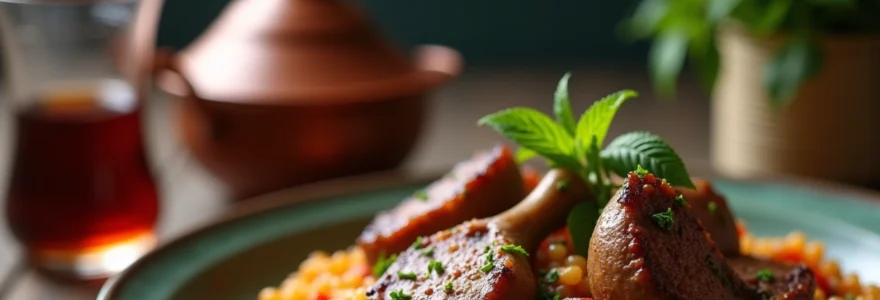Moroccan cuisine is a vibrant tapestry of flavours, aromas, and culinary traditions that have evolved over centuries. At the heart of this rich gastronomic heritage lie three iconic elements: the aromatic tagine, the versatile couscous, and the ubiquitous mint tea. These cornerstones of Moroccan cooking not only reflect the country’s diverse cultural influences but also showcase the ingenuity and creativity of its people in crafting delectable dishes from simple ingredients.
From the bustling souks of Marrakech to the tranquil kitchens of rural villages, Moroccan cuisine tells a story of innovation, hospitality, and a deep connection to the land. As you embark on this culinary journey, prepare to be captivated by the intricate spice blends, slow-cooking techniques, and time-honoured rituals that make Moroccan food a true feast for the senses.
Tagine mastery: techniques and regional variations
The tagine, both a cooking vessel and the dish it produces, is perhaps the most recognisable symbol of Moroccan cuisine. This conical clay pot has been used for centuries to create tender, flavourful stews that are the epitome of comfort food. The unique shape of the tagine allows for efficient steam circulation, resulting in melt-in-your-mouth meats and vegetables infused with complex spice blends.
Marrakech-style lamb tagine with ras el hanout
In the heart of Marrakech, you’ll find tagines that showcase the city’s love for bold flavours. A classic Marrakech-style lamb tagine often features tender chunks of meat slow-cooked with dried fruits, almonds, and a generous dose of ras el hanout , a spice blend that translates to “top of the shop”. This aromatic mixture typically includes cardamom, cumin, coriander, and cinnamon, creating a harmonious balance of sweet and savoury notes.
Coastal essaouira fish tagine with preserved lemon
Along the Atlantic coast, in cities like Essaouira, seafood tagines reign supreme. These lighter variations often incorporate delicate white fish, succulent prawns, and aromatic herbs. A hallmark of coastal tagines is the use of preserved lemon, which imparts a unique tangy flavour and brightens the dish. The combination of fresh seafood and preserved lemon creates a tagine that is both refreshing and deeply satisfying.
Vegetarian berber tagine from the atlas mountains
In the rugged terrain of the Atlas Mountains, Berber communities have perfected vegetarian tagines that showcase the bounty of their gardens. These hearty stews often feature a medley of seasonal vegetables such as carrots, turnips, and pumpkin, seasoned with warming spices like cumin and paprika. Chickpeas or fava beans are frequently added for protein, resulting in a nourishing meal that reflects the self-sufficiency of Berber culture.
Slow-cooking methods: charcoal vs gas vs electric tagines
While traditional tagines are cooked over charcoal, modern adaptations have led to the use of gas and electric heat sources. Charcoal imparts a subtle smokiness to the dish and allows for precise temperature control, but requires more attention. Gas stoves offer convenience and consistent heat, making them popular in urban households. Electric tagines, while less authentic, provide a safe and easy option for those new to Moroccan cooking.
The true art of tagine cooking lies not in the heat source, but in the patience and care taken to layer flavours and allow them to meld over time.
Couscous craftsmanship: from grain to gourmet
Couscous, often referred to as the national dish of Morocco, is a testament to the country’s culinary ingenuity. This versatile grain, made from semolina, has been a staple of North African cuisine for centuries. The preparation of couscous is an art form in itself, requiring skill, patience, and a deep understanding of texture and flavour.
Hand-rolling techniques: belboula vs semolina couscous
Traditional couscous-making is a labour-intensive process that involves hand-rolling semolina flour with water to form tiny granules. Belboula , a coarser variant made from barley, is prepared using similar techniques but results in a heartier texture. The skill of hand-rolling couscous is often passed down through generations, with each family having its own subtle variations in technique.
Seven vegetables couscous: A fez specialty
In the culinary capital of Fez, couscous reaches new heights of sophistication with the renowned “seven vegetables” variation. This elaborate dish typically includes a medley of seasonal vegetables such as carrots, turnips, zucchini, and pumpkin, along with chickpeas and fava beans. The vegetables are carefully arranged atop a mound of fluffy couscous, creating a visually stunning presentation that’s as pleasing to the eye as it is to the palate.
Tfaya: caramelized onion and raisin couscous topping
Tfaya is a sweet and savoury topping that elevates couscous to new levels of indulgence. This concoction of caramelized onions, plump raisins, and aromatic spices like cinnamon and saffron adds depth and complexity to the dish. The contrast between the sweet tfaya and the savoury couscous creates a harmonious balance that is characteristic of Moroccan cuisine.
Couscous seffa: sweet and savoury almonds and cinnamon
For those with a sweet tooth, couscous seffa offers a delightful departure from traditional savoury preparations. This dessert-like variation features couscous steamed with butter, cinnamon, and powdered sugar, then topped with toasted almonds and a dusting of cinnamon. Often served at special occasions, couscous seffa showcases the versatility of this humble grain in Moroccan culinary traditions.
Mint tea ceremony: the art of moroccan hospitality
No exploration of Moroccan cuisine would be complete without delving into the ritual of mint tea. More than just a beverage, mint tea is a symbol of hospitality, friendship, and the art of slowing down to savour life’s simple pleasures. The preparation and serving of mint tea is a ceremonial act that holds great cultural significance in Morocco.
Tea varietals: gunpowder green vs touareg mint
The foundation of Moroccan mint tea is typically gunpowder green tea, a Chinese variety known for its strong, slightly smoky flavour. This is combined with fresh mint leaves, which impart a refreshing coolness to the brew. In the southern regions, particularly among Touareg communities, a variation using dried mint leaves called Touareg mint is popular. This creates a more intense, herbaceous flavour profile that stands up well to the desert heat.
Traditional pouring techniques and etiquette
The art of pouring Moroccan mint tea is a spectacle in itself. The tea is poured from a height into small, ornate glasses, creating a frothy head and aerating the tea. This process, known as atay , is repeated several times to ensure proper mixing and temperature. Etiquette dictates that the host tastes the tea first to ensure its quality before serving guests, and it’s considered polite to accept at least two glasses when offered.
The height of the pour and the skill with which it is executed are matters of pride for Moroccan hosts, with some able to achieve impressively high pours without spilling a drop.
Regional herb additions: wormwood, sage, and lemon verbena
While mint is the most common herb used in Moroccan tea, regional variations incorporate other aromatic plants to create unique flavour profiles. In some areas, wormwood is added for its bitter notes, while sage lends a earthy, slightly medicinal quality. Lemon verbena , known locally as louiza , is prized for its citrusy aroma and is often used to aid digestion after heavy meals.
Spice souk exploration: essential moroccan flavour profiles
The spice souks of Morocco are a sensory wonderland, filled with pyramids of colourful powders and the heady aromas of exotic spices. These markets are the heart of Moroccan cuisine, providing the essential ingredients that give the country’s dishes their distinctive flavour profiles. Navigating these vibrant marketplaces is an adventure in itself, offering insights into the complex world of Moroccan spices.
Ras el hanout: crafting the ‘top of the shop’ blend
Ras el hanout , which translates to “head of the shop”, is the crown jewel of Moroccan spice blends. Each spice merchant guards their own secret recipe, which can contain anywhere from a dozen to over 30 different spices. Common ingredients include cardamom, cumin, cinnamon, coriander, and rose petals, creating a complex and aromatic mixture that is used in a wide variety of dishes, from tagines to marinades.
Preserved lemons: fermentation process and culinary uses
Preserved lemons are a cornerstone of Moroccan cuisine, lending a unique tangy and salty flavour to many dishes. The process of preserving lemons involves quartering the fruits, packing them with salt, and allowing them to ferment for several weeks. The result is a versatile ingredient that can be used in tagines, salads, and sauces, adding depth and brightness to any dish it touches.
Argan oil: from berber tradition to culinary stardom
Argan oil, once a little-known Berber staple, has gained international recognition for its nutritional and cosmetic properties. In Moroccan cuisine, this golden oil is prized for its nutty flavour and is used in both sweet and savoury applications. From drizzling over couscous to being the star ingredient in amlou , a spread made with almonds and honey, argan oil showcases the unique flavours of Morocco’s southwestern regions.
Moroccan bread culture: from khobz to msemen
Bread holds a sacred place in Moroccan culture, serving not just as sustenance but as a symbol of community and hospitality. The variety of breads found across Morocco reflects the country’s diverse regions and culinary traditions. From the ubiquitous khobz to the flaky msemen , Moroccan breads are an integral part of every meal.
Wood-fired ovens: the heart of traditional bakeries
In many Moroccan neighbourhoods, the communal wood-fired oven, or ferran , is a central gathering place. Families bring their shaped dough to be baked in these large ovens, which impart a distinctive smoky flavour to the bread. The process of baking bread in a ferran is not just about producing food; it’s a social activity that strengthens community bonds and preserves traditional baking methods.
Rghaif: laminated flatbread techniques
Rghaif , also known as meloui , is a flaky, layered flatbread that showcases the skill of Moroccan bakers. The dough is stretched incredibly thin, folded multiple times to create layers, and then cooked on a griddle. The result is a crispy exterior with a soft, chewy interior that’s perfect for soaking up sauces or enjoying with honey and butter for breakfast.
Harcha: semolina griddle cakes of casablanca
In Casablanca and other coastal cities, harcha is a popular street food and breakfast item. These semolina griddle cakes are crispy on the outside and tender on the inside, often served split and filled with cheese, honey, or jam. The grainy texture of harcha comes from the use of semolina instead of flour, giving it a unique mouthfeel that sets it apart from other Moroccan breads.
As you delve deeper into the world of Moroccan cuisine, you’ll discover that each dish, spice blend, and culinary tradition tells a story of cultural exchange, innovation, and a deep respect for ingredients. From the slow-cooked tagines that fill homes with tantalizing aromas to the precise art of tea pouring that welcomes guests, Moroccan food culture is a celebration of flavour, hospitality, and the joy of sharing a meal. By embracing these culinary traditions, you not only satisfy your palate but also gain insight into the rich tapestry of Moroccan life and history.


